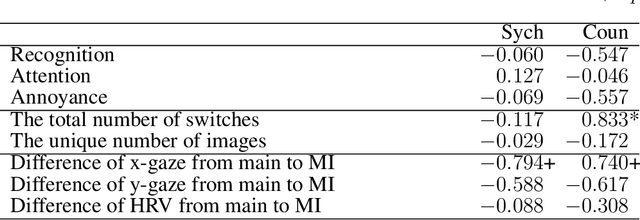Junya Morita
Modeling Task Immersion based on Goal Activation Mechanism
Dec 06, 2024Abstract:Immersion in a task is a prerequisite for creativity. However, excessive arousal in a single task has drawbacks, such as overlooking events outside of the task. To examine such a negative aspect, this study constructs a computational model of arousal dynamics where the excessively increased arousal makes the task transition difficult. The model was developed using functions integrated into the cognitive architecture Adaptive Control of Thought-Rational (ACT-R). Under the framework, arousal is treated as a coefficient affecting the overall activation level in the model. In our simulations, we set up two conditions demanding low and high arousal, trying to replicate corresponding human experiments. In each simulation condition, two sets of ACT-R parameters were assumed from the different interpretations of the human experimental settings. The results showed consistency of behavior between humans and models both in the two different simulation settings. This result suggests the validity of our assumptions and has implications of controlling arousal in our daily life.
Cognitive Architecture Toward Common Ground Sharing Among Humans and Generative AIs: Trial on Model-Model Interactions in Tangram Naming Task
Nov 10, 2023Abstract:For generative AIs to be trustworthy, establishing transparent common grounding with humans is essential. As a preparation toward human-model common grounding, this study examines the process of model-model common grounding. In this context, common ground is defined as a cognitive framework shared among agents in communication, enabling the connection of symbols exchanged between agents to the meanings inherent in each agent. This connection is facilitated by a shared cognitive framework among the agents involved. In this research, we focus on the tangram naming task (TNT) as a testbed to examine the common-ground-building process. Unlike previous models designed for this task, our approach employs generative AIs to visualize the internal processes of the model. In this task, the sender constructs a metaphorical image of an abstract figure within the model and generates a detailed description based on this image. The receiver interprets the generated description from the partner by constructing another image and reconstructing the original abstract figure. Preliminary results from the study show an improvement in task performance beyond the chance level, indicating the effect of the common cognitive framework implemented in the models. Additionally, we observed that incremental backpropagations leveraging successful communication cases for a component of the model led to a statistically significant increase in performance. These results provide valuable insights into the mechanisms of common grounding made by generative AIs, improving human communication with the evolving intelligent machines in our future society.
Emotion in Cognitive Architecture: Emergent Properties from Interactions with Human Emotion
Dec 28, 2022Abstract:This document presents endeavors to represent emotion in a computational cognitive architecture. The first part introduces research organizing with two axes of emotional affect: pleasantness and arousal. Following this basic of emotional components, the document discusses an aspect of emergent properties of emotion, showing interaction studies with human users. With these past author's studies, the document concludes that the advantage of the cognitive human-agent interaction approach is in representing human internal states and processes.
Estimating Personal Model Parameters from Utterances in Model-based Reminiscence
Aug 18, 2022



Abstract:Reminiscence therapy is mental health care based on the recollection of memories. However, the effectiveness of this method varies amongst individuals. To solve this problem, it is necessary to provide more personalized support; therefore, this study utilized a computational model of personal memory recollection based on a cognitive architecture adaptive control of thought-rational (ACT-R). An ACT-R memory model reflecting the state of users is expected to facilitate personal recollection. In this study, we proposed a method for estimating the internal states of users through repeated interactions with the memory model. The model, which contains the lifelog of the user, presents a memory item (stimulus) to the user, and receives the response of the user to the stimulus, based on which it adjusts the internal parameters of the model. Through the repetition of these processes, the parameters of the model will reflect the internal states of the user. To confirm the feasibility of the proposed method, we analyzed utterances of users when using a system that incorporates this model. The results confirmed the ability of the method to estimate the memory retrieval parameters of the model from the utterances of the user. In addition, the ability of the method to estimate changes in the mood of the user caused by using the system was confirmed. These results support the feasibility of the interactive method for estimating human internal states, which will eventually contribute to the ability to induce memory recall and emotions for our well-being.
Regulating Ruminative Web-browsing Based on the Counterbalance Modeling Approach
Sep 20, 2021



Abstract:Even though the web environment facilitates daily life, emotional problems caused by its incompatibility with human cognition are becoming increasingly serious. To alleviate negative emotions during web use, we developed a browser extension that presents memorized product images to users, in the form of web advertisements. This system utilizes the cognitive architecture Adaptive Control of Thought-Rational (ACT-R) as a model of memory and emotion. A heart rate sensor modulates the ACT-R model parameters: The emotional states of the model are synchronized or counterbalanced with the physiological state of the user. An experiment demonstrates that the counterbalance model suppresses negative ruminative web browsing. The authors claim that this approach is advantageous in terms of explainability.
 Add to Chrome
Add to Chrome Add to Firefox
Add to Firefox Add to Edge
Add to Edge